-
 Iron tsuba of round form, slightly convex, decorated with persimmon (kaki), simplified Genji-kō (incense game symbol) and halves of plum blossoms (ume) in brass inlay on both sides, and with part of bellflower (kikyo) in openwork. Outer rim, seppa-dai, bellflower openwork, and kozuka-ana outlined with brass inlay; traces of lacquer to surface. The symbolic meaning alludes to Chapter 20: Asagao (朝顔, the bellflower or "morning face") of Tale of Genji by Murasaki Shikibu (11th century AD). The events take place in the 9th lunar month (Nagatsuki) and involve the following poetry by Prince Genji: saku hana ni / utsuru chō na wa / tsutsumedomo / orade sugiuki / kesa no asagao [I would not have it said / that my heart has turned toward / a flower in bloom — / yet how hard it is to pass / without plucking a “morning face”!]. Measurements: H: 76.6 mm; W: 76.3 mm; Th.: 3.6 mm (seppa-dai), 3.0 mm (rim) Time: Late Muromachi (1514 – 1573).
Iron tsuba of round form, slightly convex, decorated with persimmon (kaki), simplified Genji-kō (incense game symbol) and halves of plum blossoms (ume) in brass inlay on both sides, and with part of bellflower (kikyo) in openwork. Outer rim, seppa-dai, bellflower openwork, and kozuka-ana outlined with brass inlay; traces of lacquer to surface. The symbolic meaning alludes to Chapter 20: Asagao (朝顔, the bellflower or "morning face") of Tale of Genji by Murasaki Shikibu (11th century AD). The events take place in the 9th lunar month (Nagatsuki) and involve the following poetry by Prince Genji: saku hana ni / utsuru chō na wa / tsutsumedomo / orade sugiuki / kesa no asagao [I would not have it said / that my heart has turned toward / a flower in bloom — / yet how hard it is to pass / without plucking a “morning face”!]. Measurements: H: 76.6 mm; W: 76.3 mm; Th.: 3.6 mm (seppa-dai), 3.0 mm (rim) Time: Late Muromachi (1514 – 1573). -
 Iron tsuba of quatrefoil form (mokka-gata) adorned with the design of stars, wild geese, blossoms, leaves and tendrils realized in the brass inlay. The inlay technique includes suemon-zōgan and ten-zōgan. A smaller opening (kozuka hitsu-ana) surrounded by a scalloped brass border. The seppa-dai bordered with linear inlay. A few dots of inlay on both sides are missing. Measurements: height 71 mm, width 70 mm, thickness at centre 2.7 cm Time: Late Muromachi (1514 – 1573)
Iron tsuba of quatrefoil form (mokka-gata) adorned with the design of stars, wild geese, blossoms, leaves and tendrils realized in the brass inlay. The inlay technique includes suemon-zōgan and ten-zōgan. A smaller opening (kozuka hitsu-ana) surrounded by a scalloped brass border. The seppa-dai bordered with linear inlay. A few dots of inlay on both sides are missing. Measurements: height 71 mm, width 70 mm, thickness at centre 2.7 cm Time: Late Muromachi (1514 – 1573) -
 Iron tsuba of a round form (maru-gata) pierced (sukashi) with two six-petal flowers at 6 and 12 o’clock and modified lozenges at 3 and 9 o’clock, and inlaid in brass (suemon-zōgan) with tendrils and flowers (chrysanthemum, cherry blossom, Chinese bellflower, paulownia); openings outlined with scalloped brass wire. The plate is slightly concave with traces of lacquer on the surface. Nakago-ana plugged with copper sekigane. Some elements of inlay missing. The rim with conspicuous tekkotsu, quite worn. Measurements: Height 92.0 mm; Width 86.3 mm; thickness at seppa-dai 3.2 mm, at rim 4.2 mm. Time: Late Muromachi (1514 – 1573) or earlier.
Iron tsuba of a round form (maru-gata) pierced (sukashi) with two six-petal flowers at 6 and 12 o’clock and modified lozenges at 3 and 9 o’clock, and inlaid in brass (suemon-zōgan) with tendrils and flowers (chrysanthemum, cherry blossom, Chinese bellflower, paulownia); openings outlined with scalloped brass wire. The plate is slightly concave with traces of lacquer on the surface. Nakago-ana plugged with copper sekigane. Some elements of inlay missing. The rim with conspicuous tekkotsu, quite worn. Measurements: Height 92.0 mm; Width 86.3 mm; thickness at seppa-dai 3.2 mm, at rim 4.2 mm. Time: Late Muromachi (1514 – 1573) or earlier. -

Large iron tsuba with hammer marks on the surface, small oval opening to the right of nakaga-ana; yamagane fukurin chiselled with tortois shell diaper pattern.
Early Muromachi period (1393-1453). Size: 101.2 x 101.9 x 2.4 (center), 5.2 (rim) mm; weight: 148.4 g. -

Iron tsuba of mokkō-form with a pine and a frog on the face and a snail on the back, carved and inlaid with gold. Each figurative element of the design is signed on three inlaid cartouches: Masaharu (正春), Kazuyuki (一之), and Yoshikazu (良一) [read by Markus Sesko]. Snake, snail, and frog together make a design called "SANSUKUMI" - Three Cringing Ones [Merrily Baird]. The snail can poison the snake, the frog eats the snail, and the snake eats the frog. It's unclear whether the pine replaces the snake on this tsuba, or the snake is hiding in the pine? Anyway, the frog and the snail are clearly represented. "Maybe we have here a joint work with Masaharu (the silver cartouche next to the pine) being the master and making the plate and Kazuyuki and Yoshikazu as his students carving out the frog and the snail respectively". Copper sekigane.
Dimensions: 70.9 x 67.2 x 3.0 mm. Edo period (18th century).Markus Sesko writes: "I agree, the frog and the snail most likely allude to the san-sukumi motif. It is possible that we have here an artist's choice to deliberately leave out the snake, maybe he thought that the motif is already obvious and there is no need to add a snake to make it clear that the tsuba shows the san-sukumi motif." [Markus Sesko].
Kazuyuki (一之): adopted son of Kumagai Yoshiyuki, student of Ichijō (Gotō-Ichijō Scool) [M. Sesko 'Genealogies', page 19.] Masaharu (正春): Kasuya fam., student of Masamichi (1707-1757) who was the 4th generation Nomura School master in Edo. [M. Sesko 'Genealogies', page 49.] -

Iron tsuba in a form of an eight-petalled blossom (lotus) form, petals separated by linear low-relief carving, both hitsu-ana filled with gold plugs, the surface decorated with tsuchime-ji, rich grey-brownish patina, niku from 4 mm in the centre to 6 mm at the rim. Strong (futoji-mei) Nobuie [信家] signature to the left of nakago-ana. Attributed to the 2nd generation of Nobuie masters (Nidai Nobuie).
Size: outer diameter 84 mm, thickness at centre: 4 mm, at rim: 6 mm. Wight: 167 g.Signed: Nobuie [信家]
Probably the work of Nidai Nobuie (c. 1600).
The gold plugs are likely a later work. -

Iron tsuba of mokko form decorated with arabesque (karakusa) in low relief carving. niku from 4.0 mm in the centre to 5.1 mm at the rim. Strong Nobuie [信家] signature (futoji-mei) to the left of nakago-ana. Hitsuana plugged with pewter.
Size: H: 88.2 mm, W: 83.6, Th(c): 4.0 mm, Th(r): 5.1 mm Weight: 167 g.Signed: Nobuie [信家]
Probably the work of Nidai Nobuie (c. 1600).
Tokubetsu hozon certificate № 229324 of the N.B.T.H.K., dated 22.12.2010 -
 Iron tsuba of mokko form decorated with encircled family crests in low relief carving; niku from 3.0 mm in the centre to 4.0 mm at rim and full 1 mm raised uchikaeshi-mimi. Nobuie [信家] signature (hanare-mei) to the left of nakago-ana; on the reverse, to the right of nakago-ana, the inscription reads “62”, which may be how old the master was at the age of making the tsuba. Pewter or lead plugged hitsuana. In a wooden box, in a custom pouch. Size: H: 80 mm, W: 75, Th(c): 3.1 mm, Th(r): 4.0 mm Weight: 103.5 g
Iron tsuba of mokko form decorated with encircled family crests in low relief carving; niku from 3.0 mm in the centre to 4.0 mm at rim and full 1 mm raised uchikaeshi-mimi. Nobuie [信家] signature (hanare-mei) to the left of nakago-ana; on the reverse, to the right of nakago-ana, the inscription reads “62”, which may be how old the master was at the age of making the tsuba. Pewter or lead plugged hitsuana. In a wooden box, in a custom pouch. Size: H: 80 mm, W: 75, Th(c): 3.1 mm, Th(r): 4.0 mm Weight: 103.5 gSigned: Nobuie [信家] / 62
Probably the work of Shodai Nobuie (c. 1580).
Tokubetsu hozon certificate № 2002993 of the N.B.T.H.K., dated January 15, 2016. NOBUIE TSUBA by Steve Waszak The iron tsuba made by the two early Nobuie masters are regarded as the greatest sword guards ever made across hundreds of years of Japanese history. Only a small handful of other smiths' names are even mentioned in the same breath as that of Nobuie. Despite the well-deserved fame of the Nobuie name, virtually nothing is known with certainty about the lives of the two men who made the pieces carrying this name. They are thought to have been men of Owari Province, with the Nidai Nobuie also spending time in Aki Province at the end of the Momoyama Period. Two Nobuie tsubako are recognized. The man whom most consider to have been the Shodai signed his sword guards with finer and more elegantly inscribed characters than the smith seen by most as the Nidai. The term used to describe the mei of the Shodai is "hanare-mei" or "ga-mei," while that used to characterize the signature of the Nidai is "futoji-mei" or "chikara-mei." These terms refer to the fineness and grace of the Shodai's signature and the relatively more powerfully inscribed characters of the Nidai's. The Shodai is thought to have lived during the Eiroku and Tensho eras in the latter part of the 16th century, while the Nidai's years are considered to have been from Tensho into the Genna era. This locates both smiths well within the Golden Age of tsuba artists -- the Momoyama Period. Nobuie tsuba are esteemed and celebrated for the extraordinary beauty of their iron. The combination of the forging of the metal, the surface treatment by tsuchime and yakite married to powerfully expressive carving, the masterful manipulation of form, mass and shape, and the colour and patina of the iron makes Nobuie sword guards not only unique in the world of tsuba, but the greatest of the great. The sword guard here is a Shodai-made masterwork, done in mokko-gata form, a shape the early Nobuie smiths mastered to a degree unmatched by any others. The expanding of the mass of the tsuba from the seppa-dai to the mimi, increasing by 50% from the centre of the guard to the rim, creates a sense of exploding energy, which is then contained by the uchikaeshi-mimi, yielding a lightning-in-a-bottle effect of captured energy. The hammering the master has employed to finish the surface is subtle and sensitive, achieving a resonant profundity, and the deep blue-black colour -- augmented by a lustrous patina -- leaves the tsuba to positively glow in one's hand. In this piece, Nobuie has used a motif of several kamon, or family crests, each carved only lightly on the surface in a loose ring around the nakago-ana. Due to the shallow depth of this carving, together with the tsuchime finish of the plate, the effect is to leave the kamon with a sort of weathered appearance, recalling the prime aesthetic values of sabi and wabi, which had great circulation in the Tea Culture so ascendant in the Momoyama years. However, the effects of sabi and wabi expressed in the treatment described above are amplified and deepened by the color and patina of the iron, thereby adding yet another aesthetic value -- yuugen -- which is linked with the abiding mystery of the universe and one more — mono no aware — which alludes to the pathos of life's experiences and transitory nature. In short, this Nobuie tsuba joins poetry with power and therein exemplifies the unrivalled brilliance of Nobuie workmanship. -
 Iron tsuba of oval form with design of stylized paulownia (nage-giri) in openwork (sukashi). Leaf veins carved in kebori technique. Rounded rim. Copper sekigane. Unsigned. Attributed to Kanshirō, third generation Nishigaki (1680-1761). Edo period: Early 18th century (Kyoho / Genbun era). Size: Height: 77.8 mm. Width: 71.9 mm. Rim thickness: 5.9 mm. Center thickness: 5.0 mm. Provenance: Sasano Masayuki Collection, № 264: "Nishigaki. Third generation Kanshiro (died in in the eleventh year of Hohreki, 1761 at the age of eighty-two). This oblong shape appears a little amateurish at first, however, it was done intentionally to add flavor to to the design. The neat composition is a feature of the third Kanshiro."
Iron tsuba of oval form with design of stylized paulownia (nage-giri) in openwork (sukashi). Leaf veins carved in kebori technique. Rounded rim. Copper sekigane. Unsigned. Attributed to Kanshirō, third generation Nishigaki (1680-1761). Edo period: Early 18th century (Kyoho / Genbun era). Size: Height: 77.8 mm. Width: 71.9 mm. Rim thickness: 5.9 mm. Center thickness: 5.0 mm. Provenance: Sasano Masayuki Collection, № 264: "Nishigaki. Third generation Kanshiro (died in in the eleventh year of Hohreki, 1761 at the age of eighty-two). This oblong shape appears a little amateurish at first, however, it was done intentionally to add flavor to to the design. The neat composition is a feature of the third Kanshiro." -
 Iron tsuba of quatrefoil form with design of bamboo stems and leaves, and a plank bridge in openwork (sukashi). Hitsu-ana of irregular form. Iron with smooth chocolate patina. Copper and shakudō sekigane. This piece is illustrated in Sasano: Japanese Sword Guard Masterpieces from the Sasano Collection, 1994 on page 295 under № 254 with the following description:
Iron tsuba of quatrefoil form with design of bamboo stems and leaves, and a plank bridge in openwork (sukashi). Hitsu-ana of irregular form. Iron with smooth chocolate patina. Copper and shakudō sekigane. This piece is illustrated in Sasano: Japanese Sword Guard Masterpieces from the Sasano Collection, 1994 on page 295 under № 254 with the following description:Nishigaki. First generation Kanshiro (died in the sixth year of Genroku, 1693, at the age of 81). Sukashi design: Bamboo (take). Early Edo period, late 17th century (Kanbun / Enppo era). Height: 72.6 mm; Width: 71.5 mm; Rim thickness: .6 mm; Centre thickness: 5.1 mm. Rounded rim. The shape of this sword guard is a quatrefoil and the design is arranged in the form of a saddle flap. Two bamboo trunks with leaves comprise the design. Calm, soothing and sophisticated are the features of this artist in his later years. Such characteristics may remind one of the work of the first Hikozo.
Provenance: Sasano Masayuki collection, № 254. What is interesting, and what had been found by Bruce Kirkpatrick, is that in the earlier photograph of the same piece ['Sukashi tsuba - bushido no bi' by Sasano Masayuki, photography by Fujimoto Shihara, 1972 (in Japanese), page 245, №201] we clearly see kebori - linear carving that decorates the bamboo leaves and the planks of the bridge. The said kebori have totally disappeared between 1972 and 1994. The tsuba became absolutely flat! Now we can only speculate about the reasons for such cruel treatment of the artistically and historically important item.
Sukashi tsuba - bushido no bi. Author: Sasano Masayuki, photography: Fujimoto Shihara, 1972 (in Japanese). Page 245, №201.
-
 Iron tsuba of quatrefoil form with design of bamboo stems and leaves in openwork (sukashi) decorated with carving (kebori) . Copper sekigane. Early Edo period, late 17th century (Kanbun / Enppo era). First generation Kanshiro of Nishigaki school in Higo Province died in the sixth year of Genroku, 1693, at the age of 81). Height: 74.4 mm; Width: 74.2 mm; Centre thickness: 4.9 mm. Rounded rim. The design was quite popular among the Higo masters.
Iron tsuba of quatrefoil form with design of bamboo stems and leaves in openwork (sukashi) decorated with carving (kebori) . Copper sekigane. Early Edo period, late 17th century (Kanbun / Enppo era). First generation Kanshiro of Nishigaki school in Higo Province died in the sixth year of Genroku, 1693, at the age of 81). Height: 74.4 mm; Width: 74.2 mm; Centre thickness: 4.9 mm. Rounded rim. The design was quite popular among the Higo masters.
Kanshiro III, early 18th century (Sasano 1994 №267)

Matashichi I, late 17th century (Sasano 1994 №270)
The design of my tsuba closely resembles the one at the last example (Sasano 1994 №280), however, the form (mine is quatrefoil) and the execution (strength) are very different, which result in a very different spirit of my piece.
Shigemitsu II, early 18th century (Sasano 1994 №280)
-
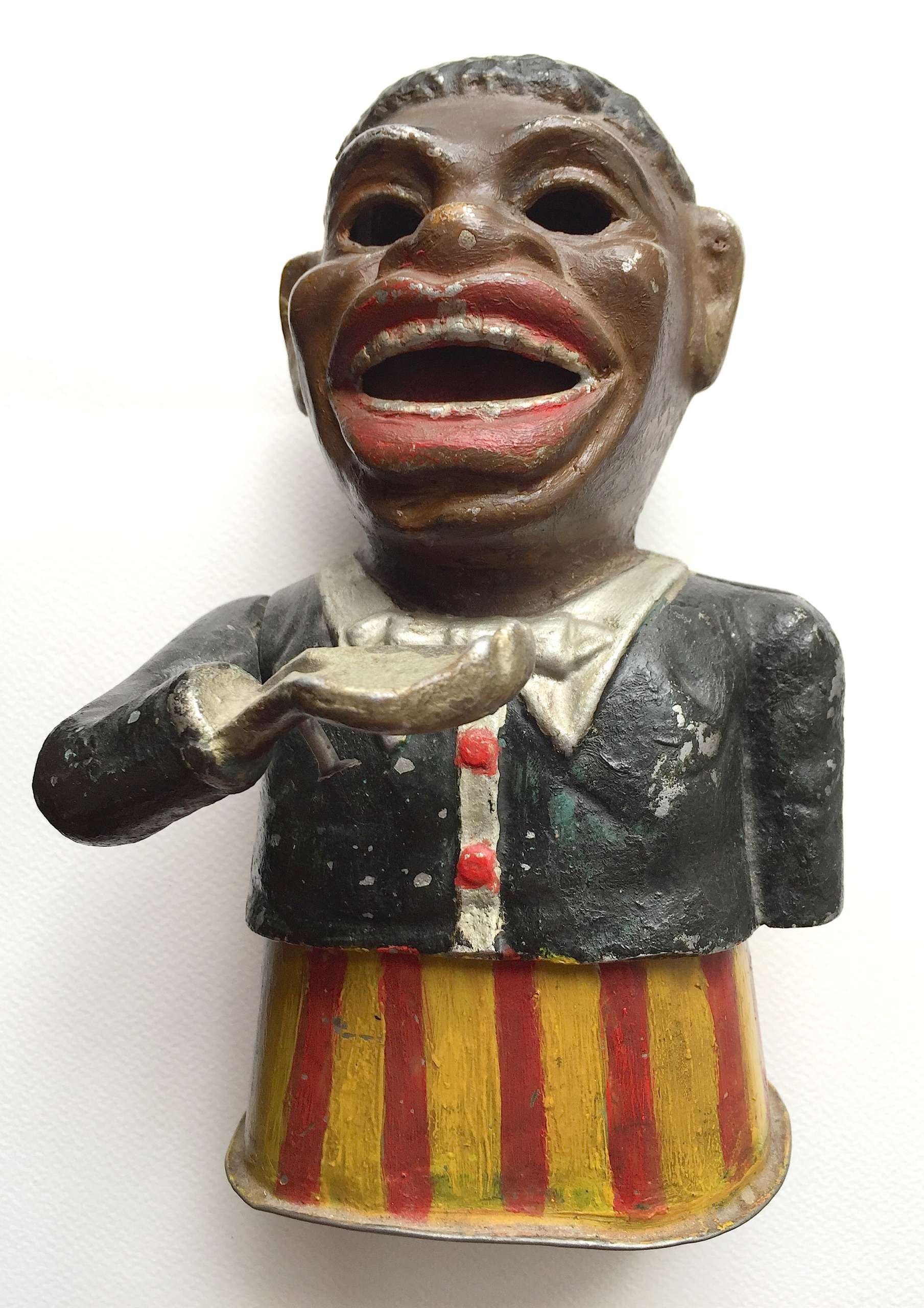 A cast iron painted 19th century style money box in the form of a negro, the arm articulated to insert coins.
A cast iron painted 19th century style money box in the form of a negro, the arm articulated to insert coins. -
 Iron tsuba with brown patina in mokkō-gata form with woven design. Size: 72 x 67 x 5 mm.
Iron tsuba with brown patina in mokkō-gata form with woven design. Size: 72 x 67 x 5 mm. -
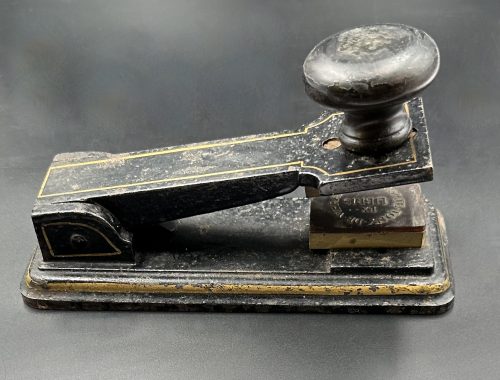 Iron pliers painted black and outlined in gilt lacquer, with wooden handle and bronze seals, "Ex Libris Comte Tony de Vibraye", L17.1 x W6.9 x H7.5 cm. Provenance: Antoine Henri Gaston Hurault de Vibraye [Comte Tony de Vibraye] (French, 1893 – 1951). The book with such a stamp in this library: [LIB-3243.2023] Crébillon fils. La Nuit et le moment ou Les Matinées de Cythère / Illustrations de Sylvain Sauvage. — Paris: Au dépens d’un amateur, 1924.
Iron pliers painted black and outlined in gilt lacquer, with wooden handle and bronze seals, "Ex Libris Comte Tony de Vibraye", L17.1 x W6.9 x H7.5 cm. Provenance: Antoine Henri Gaston Hurault de Vibraye [Comte Tony de Vibraye] (French, 1893 – 1951). The book with such a stamp in this library: [LIB-3243.2023] Crébillon fils. La Nuit et le moment ou Les Matinées de Cythère / Illustrations de Sylvain Sauvage. — Paris: Au dépens d’un amateur, 1924. -
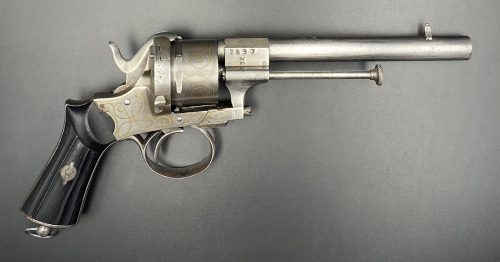 Serial number 8697, barrel 14.5 cm, calibre 9 mm Lefaucheux M-1858 double-action pin-fire revolver manufactured in the late 1860-s. Produced in France with no retailers marking but having French proofs on front of the cylinder and right side of barrel trunnion. The metal remains in the white with small gold wire inlays. Fluted 2 piece ebony grips. This pattern has been observed in civil war photographs and excavated from battlefields and camps in the United States. Dimensions: L: 25 cm; H: 13 cm; Barrel: 14.5 cm.
Serial number 8697, barrel 14.5 cm, calibre 9 mm Lefaucheux M-1858 double-action pin-fire revolver manufactured in the late 1860-s. Produced in France with no retailers marking but having French proofs on front of the cylinder and right side of barrel trunnion. The metal remains in the white with small gold wire inlays. Fluted 2 piece ebony grips. This pattern has been observed in civil war photographs and excavated from battlefields and camps in the United States. Dimensions: L: 25 cm; H: 13 cm; Barrel: 14.5 cm. -
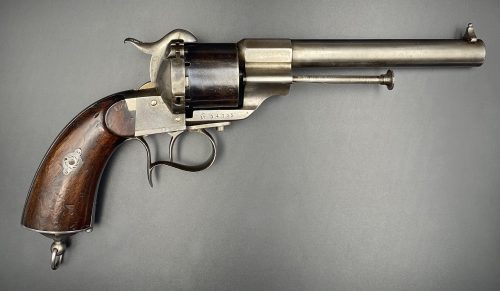
Six shot 11-millimetre Lefaucheux Brevete M-1854 single-action pin-fire revolver, serial #34755. French large calibre revolver features octagon to round barrel, non-fluted cylinder, walnut grips with the heavy pommel.
Manufactured in Paris.
Dimensions: L: 29.5 cm; H: 15.5 cm; Barrel: 16 cm. -
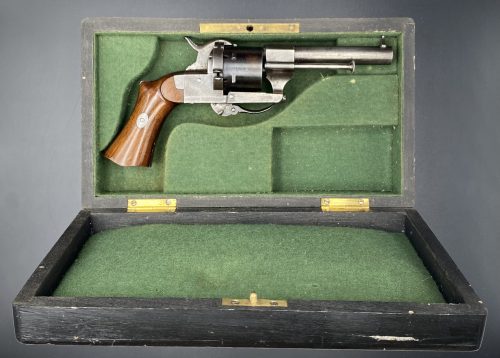
Lefaucheux model 1858 pin-fire self-cocking revolver with ejector rod, folding trigger and polished walnut grips, manufactured in Paris.
Stamped on barrel: E. LEFAUCHEUX BRte S.G.D.G. À PARIS.
Serial number LF 9018; in a wooden case. Dimensions: Case: 23 x 13 x 6 cm; L: 20.5 cm; H: 9 cm; Barrel: 9 cm. Eugene Lefaucheux (French, 1820 – 1871) was the son of Casimir Lefaucheux (French, 1802 – 1852). -
 Iron tsuba of round form with design of water plantain (omodaka) and wild goose in openwork (sukashi). Slightly rounded, square rim. Copper sekigane. Kyo school. Late Muromachi period: Early 16th century (Tenbun era) [Sasano's attribution]. Height: 76.2 mm. Width: 75.8 mm. Rim thickness: 5.3 mm. Center thickness: 4.5 mm. Provenance: Sasano Masayuki Collection, № 68: "The water plantain (omodaka) first appeared as a design for sword fittings in the Heian period. From such early beginnings, this decorative plant has shared a long history with the samurai. Also known as shogun's grass (shogununso), it was held in high esteem as a symbol of victory". The same tsuba was found at Japanese Swords and Tsuba from the Professor A. Z. Freeman and the Phyllis Sharpe Memorial collections. Sotheby's, London, Thursday 10 April 1997, page 22, item 60, saying that this is a "Kyo-sukashi tsuba, early to middle Edo period (late 17th/18th century) [Sotheby's attribution], and that it represents "a small bird among omodaka and aoi plants".
Iron tsuba of round form with design of water plantain (omodaka) and wild goose in openwork (sukashi). Slightly rounded, square rim. Copper sekigane. Kyo school. Late Muromachi period: Early 16th century (Tenbun era) [Sasano's attribution]. Height: 76.2 mm. Width: 75.8 mm. Rim thickness: 5.3 mm. Center thickness: 4.5 mm. Provenance: Sasano Masayuki Collection, № 68: "The water plantain (omodaka) first appeared as a design for sword fittings in the Heian period. From such early beginnings, this decorative plant has shared a long history with the samurai. Also known as shogun's grass (shogununso), it was held in high esteem as a symbol of victory". The same tsuba was found at Japanese Swords and Tsuba from the Professor A. Z. Freeman and the Phyllis Sharpe Memorial collections. Sotheby's, London, Thursday 10 April 1997, page 22, item 60, saying that this is a "Kyo-sukashi tsuba, early to middle Edo period (late 17th/18th century) [Sotheby's attribution], and that it represents "a small bird among omodaka and aoi plants".


